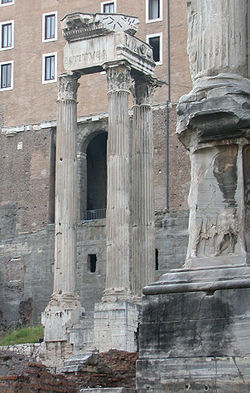 Temple of Vespasian and Titus | |
 Click on the map for a fullscreen view | |
| Location | Regio VIII Forum Romanum |
|---|---|
| Coordinates | 41°53′34″N12°29′02″E / 41.892727°N 12.483891°E |
| Type | Roman Temple |
| History | |
| Builder | Titus and Domitian |
| Founded | 79 |
The Temple of Vespasian and Titus (Latin : Templum divi Vespasiani, [1] Italian : Tempio di Vespasiano) is located in Rome at the western end of the Roman Forum between the Temple of Concordia and the Temple of Saturn. It was dedicated to the deified Vespasian and his son, the deified Titus. It was begun by Titus in 79 after Vespasian's death and Titus's succession. Titus’ brother, Domitian, completed and dedicated the temple to Titus and Vespasian in approximately 87.


